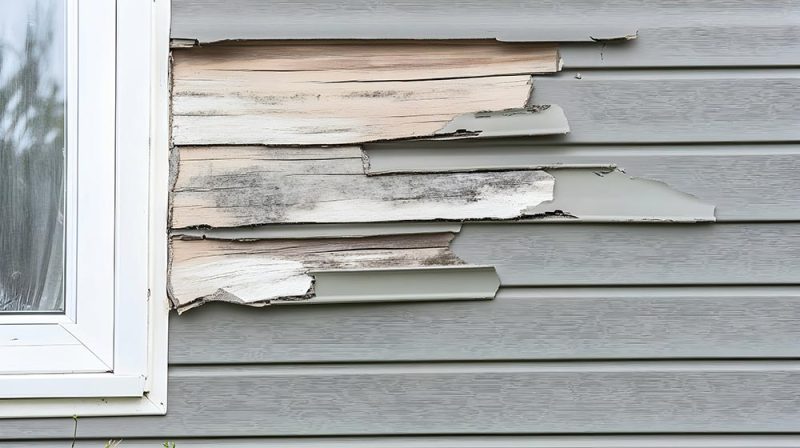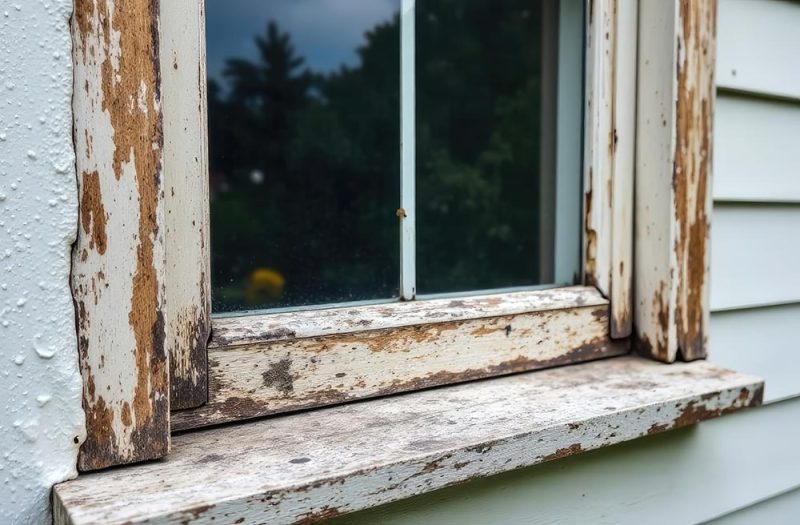Protecting Texas Homes from the Outside In
Your home’s exterior is its first line of defense against the elements—especially here on the Texas coast, where intense sun, wind, humidity, and salt air are constant challenges. Over time, even the toughest materials will begin to wear down. When small exterior issues are ignored, they can quickly escalate into major repairs that cost thousands more to fix later.
At Bayfront Exteriors, we’ve seen firsthand how minor cracks, leaks, and paint problems turn into water damage, mold, and structural issues. The good news? Most exterior damage gives you plenty of warning—if you know what to look for.
Here are the most common signs your home needs exterior repairs before it’s too late.
Cracked or Warped Siding
Your siding does more than just add curb appeal—it protects the internal structure of your home from water and wind. If you notice cracks, warping, bulging, or gaps in your siding, it’s time to act. These signs can indicate moisture has already seeped in, which could lead to rot or mold growth underneath.
In coastal areas like Corpus Christi and Rockport, salty air can accelerate wear and tear on both vinyl and wood siding. Early repairs or replacements are much cheaper than waiting for full sections of siding to fail.

Peeling Paint or Faded Surfaces
Paint isn’t just for looks—it also serves as a protective layer, especially for wood and stucco exteriors. When paint begins to peel, bubble, or fade, the underlying material becomes exposed to moisture and UV rays, which can degrade it over time.
South Texas sun can be brutal on painted surfaces, and repainting or touch-ups every 5–7 years can help prevent more expensive repairs later on.

Rotting Wood Trim or Fascia Boards
Fascia, soffits, and other wood trim around your roofline and windows are especially vulnerable to moisture damage. If you spot soft spots, discoloration, or visible rot, don’t wait. These boards are critical to roof structure and water control. Left untreated, rotting trim can lead to roof leaks and pest infestations.
We often replace these components as part of full exterior repair jobs, especially after storms or long periods of neglect.
Gutter Problems and Poor Drainage
Your gutters are designed to direct water away from your home’s foundation. If they’re sagging, leaking, clogged, or pulling away from the fascia, they’re not doing their job. And that means water may be seeping into your walls or pooling around your foundation—both of which can cause long-term structural damage.
Visible stains on siding or puddles near the base of your home after rain are signs your gutters need attention. Sometimes, a simple repair is all it takes. Other times, a full replacement is smarter to prevent further damage.
Cracks in Stucco or Brickwork
Hairline cracks in stucco may not seem like a big deal, but they can let in water, leading to interior wall damage or mold. Likewise, cracked mortar in brickwork (known as “tuckpointing” issues) can signal that your home’s protective barrier is breaking down.
These materials are designed to last decades—but only if maintained. Coastal humidity and occasional freezing temperatures can cause cracks to widen faster, so regular inspection is key.
Water Damage Around Windows and Doors
The framing around your windows and doors is especially vulnerable to leaks. Water can seep in through cracked seals, deteriorating caulk, or rotted frames—especially during wind-driven rain common in hurricanes and tropical storms.
Look for discoloration, softness, or swelling around the edges of windows and doors. Replacing damaged trim and resealing openings promptly helps keep moisture out and preserves energy efficiency.

Mold, Mildew, or Algae on Exterior Surfaces
Dark streaks or greenish stains on your siding, trim, or roof can indicate the presence of mold, mildew, or algae. Not only does this reduce curb appeal, but it also points to underlying moisture problems.
Power washing might provide a temporary fix, but if the issue keeps coming back, you may need repairs to siding or roofing to address moisture intrusion.
Loose or Missing Shingles
While this falls under roofing, it’s an important sign of exterior damage. After a windstorm or hail, always check for loose or missing shingles. Coastal storms can lift shingles and allow rain to penetrate your roof structure. Catching this early can prevent leaks, interior ceiling stains, and attic mold.
Why Acting Early Matters
Delaying exterior repairs can be an expensive mistake. A cracked board today could mean waterlogged insulation tomorrow. A small patch of mold could spread inside your walls. The longer you wait, the more the damage costs in labor, materials, and disruption to your home.
And if you plan to sell your home? An aging or neglected exterior can drastically reduce curb appeal and appraised value.
Trust Bayfront Exteriors for Reliable Repairs
At Bayfront Exteriors, we specialize in diagnosing and fixing exterior problems before they become major issues. Whether it’s repairing damaged siding, replacing rotted trim, or restoring weather-worn paint, we bring local experience, quality craftsmanship, and durable materials to every job.
We proudly serve South Texas communities including Corpus Christi, Rockport, Portland, and beyond—where we understand the unique challenges coastal homeowners face.
Don’t Hesitate To Contact Us
Your home’s exterior is its first and most important defense. If you’ve noticed any of the signs listed above, don’t wait for things to get worse. Reach out to Bayfront Exteriors for a free inspection and honest assessment. We’ll help you protect your home from the elements—and from expensive surprises down the road.
Contact Bayfront Exteriors today to schedule your exterior evaluation and get ahead of repair issues before it’s too late.Protecting Texas Homes from the Outside In
Your home’s exterior is its first line of defense against the elements—especially here on the Texas coast, where intense sun, wind, humidity, and salt air are constant challenges. Over time, even the toughest materials will begin to wear down. When small exterior issues are ignored, they can quickly escalate into major repairs that cost thousands more to fix later.
At Bayfront Exteriors, we’ve seen firsthand how minor cracks, leaks, and paint problems turn into water damage, mold, and structural issues. The good news? Most exterior damage gives you plenty of warning—if you know what to look for.
Here are the most common signs your home needs exterior repairs before it’s too late.
Cracked or Warped Siding
Your siding does more than just add curb appeal—it protects the internal structure of your home from water and wind. If you notice cracks, warping, bulging, or gaps in your siding, it’s time to act. These signs can indicate moisture has already seeped in, which could lead to rot or mold growth underneath.
In coastal areas like Corpus Christi and Rockport, salty air can accelerate wear and tear on both vinyl and wood siding. Early repairs or replacements are much cheaper than waiting for full sections of siding to fail.

Peeling Paint or Faded Surfaces
Paint isn’t just for looks—it also serves as a protective layer, especially for wood and stucco exteriors. When paint begins to peel, bubble, or fade, the underlying material becomes exposed to moisture and UV rays, which can degrade it over time.
South Texas sun can be brutal on painted surfaces, and repainting or touch-ups every 5–7 years can help prevent more expensive repairs later on.

Rotting Wood Trim or Fascia Boards
Fascia, soffits, and other wood trim around your roofline and windows are especially vulnerable to moisture damage. If you spot soft spots, discoloration, or visible rot, don’t wait. These boards are critical to roof structure and water control. Left untreated, rotting trim can lead to roof leaks and pest infestations.
We often replace these components as part of full exterior repair jobs, especially after storms or long periods of neglect.
Gutter Problems and Poor Drainage
Your gutters are designed to direct water away from your home’s foundation. If they’re sagging, leaking, clogged, or pulling away from the fascia, they’re not doing their job. And that means water may be seeping into your walls or pooling around your foundation—both of which can cause long-term structural damage.
Visible stains on siding or puddles near the base of your home after rain are signs your gutters need attention. Sometimes, a simple repair is all it takes. Other times, a full replacement is smarter to prevent further damage.
Cracks in Stucco or Brickwork
Hairline cracks in stucco may not seem like a big deal, but they can let in water, leading to interior wall damage or mold. Likewise, cracked mortar in brickwork (known as “tuckpointing” issues) can signal that your home’s protective barrier is breaking down.
These materials are designed to last decades—but only if maintained. Coastal humidity and occasional freezing temperatures can cause cracks to widen faster, so regular inspection is key.
Water Damage Around Windows and Doors
The framing around your windows and doors is especially vulnerable to leaks. Water can seep in through cracked seals, deteriorating caulk, or rotted frames—especially during wind-driven rain common in hurricanes and tropical storms.
Look for discoloration, softness, or swelling around the edges of windows and doors. Replacing damaged trim and resealing openings promptly helps keep moisture out and preserves energy efficiency.

Mold, Mildew, or Algae on Exterior Surfaces
Dark streaks or greenish stains on your siding, trim, or roof can indicate the presence of mold, mildew, or algae. Not only does this reduce curb appeal, but it also points to underlying moisture problems.
Power washing might provide a temporary fix, but if the issue keeps coming back, you may need repairs to siding or roofing to address moisture intrusion.
Loose or Missing Shingles
While this falls under roofing, it’s an important sign of exterior damage. After a windstorm or hail, always check for loose or missing shingles. Coastal storms can lift shingles and allow rain to penetrate your roof structure. Catching this early can prevent leaks, interior ceiling stains, and attic mold.
Why Acting Early Matters
Delaying exterior repairs can be an expensive mistake. A cracked board today could mean waterlogged insulation tomorrow. A small patch of mold could spread inside your walls. The longer you wait, the more the damage costs in labor, materials, and disruption to your home.
And if you plan to sell your home? An aging or neglected exterior can drastically reduce curb appeal and appraised value.
Trust Bayfront Exteriors for Reliable Repairs
At Bayfront Exteriors, we specialize in diagnosing and fixing exterior problems before they become major issues. Whether it’s repairing damaged siding, replacing rotted trim, or restoring weather-worn paint, we bring local experience, quality craftsmanship, and durable materials to every job.
We proudly serve South Texas communities including Corpus Christi, Rockport, Portland, and beyond—where we understand the unique challenges coastal homeowners face.
Don’t Hesitate To Contact Us
Your home’s exterior is its first and most important defense. If you’ve noticed any of the signs listed above, don’t wait for things to get worse. Reach out to Bayfront Exteriors for a free inspection and honest assessment. We’ll help you protect your home from the elements—and from expensive surprises down the road.
Contact Bayfront Exteriors today to schedule your exterior evaluation and get ahead of repair issues before it’s too late.

